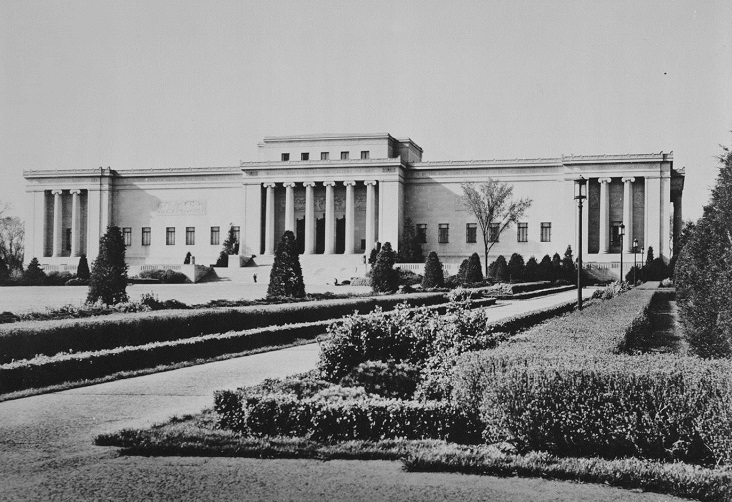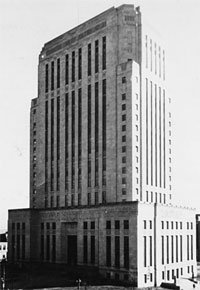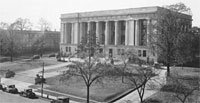On January 22, 1882, future architect William Drewin Wight was born in Halifax, Nova Scotia. In 1911, he joined his older brother, Thomas, in Kansas City, where they created the architectural firm of Wight & Wight. The firm went on to profoundly influence Kansas City's architectural landscape with prominent designs that included the Nelson-Atkins Museum of Art, the Jackson County Courthouse, the Kansas City Life Insurance Company Building, and City Hall.
William and Thomas Wight spent their childhoods in Halifax, where they partook in sports and drawing, and eventually dreamed of becoming architects. William loved ice hockey, while Thomas enjoyed canoeing, fishing, and drawing. Both brothers studied in Canadian architecture studios. Thomas, seven years older than William, emigrated to the United States in 1891 at the age of 17 and managed to find work with the celebrated architectural firm McKim, Meade & White, where he worked on the Boston Public Library. Thomas was soon hired as a permanent draftsman for the company at its New York offices. He remained there until he opened his own firm in 1904.
In 1900, the 18-year-old William Wight followed in his older brother's footsteps and went to work for McKim, Meade & White in New York. For one year during his tenure with McKim, Meade & White, he traveled through Europe and grew especially fond of medieval gothic churches. After a decade of living in New York, William decided to join his brother, who had relocated to Kansas City.
In 1904, Thomas had chosen to open a practice in Kansas City because it was (architecturally) underdeveloped, yet expanding rapidly. With his considerable background and professional connections, he expected to earn many contracts and make a mark on Kansas City. It did not hurt that his prospective business partner, Edward T. Wilder, was a close personal friend. The firm of Wilder & Wight opened in 1904, and in a few months designed the New England Bank building (which still stands, albeit with an added tower, at the corner of 10th and Baltimore.)
By 1911, William Wight had enough experience to join brother Thomas, so he bought out Edward Wilder's share of the firm, thereby creating the Wight & Wight architectural firm. The Wight brothers set out to shape Kansas City's architectural landscape. Among their most prominent designs between 1911 and the 1940s were the Kansas City Life Insurance Company Building, the Mercy and St. Joseph Hospitals, the Wyandotte County Courthouse, the Pickwick Hotel, the Nelson-Atkins Museum of Art, the Kansas City, Missouri City Hall, the Thomas Swope Memorial in Swope Park, Southeast High School, the Jackson County Courthouse, Police Headquarters, and the Clay County Courthouse in Liberty, Missouri. Perhaps the most well-known architectural achievement in this long list was the Nelson Art Gallery (main building of the present-day Nelson-Atkins Museum of Art), which best epitomized the neoclassical design elements favored by Wight & Wight.
William additionally pursued his own interests in church architecture and memorial design. In addition to the Swope Park Memorial, William oversaw the design of the frieze on Liberty Memorial's north wall, the bell tower at the Grace and Holy Trinity Cathedral, and the placement of gothic lanterns at the church to which he belonged, St. Paul's Episcopal. Sadly, though, he never fulfilled his dream of designing a large gothic-style church.
William and Thomas Wight each died of heart attacks in 1947 and 1949, respectively. In their later years, both found respite from their work in family vacations in Nova Scotia. Both were married with children, and reportedly enjoyed happy personal lives. William pursued many other hobbies before his death, including golf at the Mission Hills Country Club, gardening, deep-sea fishing, swimming, and antique collecting. He was a member of the Blue Lodge Masons, the Shriners, the St. Paul's Episcopal Church, the Kansas City Municipal Art Commission, the American Institute of Architects, and the Board of Directors of the Kansas City Art Institute. He remained active in most of these organizations until his death in 1947 at the age of 65. Along with his brother Thomas, William D. Wight left behind a physical legacy in the many Wight & Wight buildings and monuments that still adorn Kansas City today.
Read a full biographical sketch of Thomas and William D. Wight, along with profiles of buildings designed by Wight & Wight, prepared for the Missouri Valley Special Collections, the Kansas City Public Library:
- Biography of Thomas Wight (1874-1949) and William D. Wight (1882-1947), architects, by Daniel Coleman.
- Nelson-Atkins Museum of Art Building Profile, by Janice Lee.
- City Hall Profile, by Ann McFerrin.
- Jackson County Courthouse Profile, by Susan Jezak Ford.
- Liberty Memorial Profile, by Ann McFerrin; Wight & Wight designed some modifications to the memorial.
View images relating to Thomas and William D. Wight that are a part of the Missouri Valley Special Collections:
- First National Bank Building; postcard with historical article, today the building houses the Kansas City Public Library’s Central Library; designed by Wilder & Wight
- Swope Park, Thomas Swope Memorial; postcard with historical article
- Interior view of the lobby of Kansas City Life Insurance Company building, 1928
- St. Joseph's Hospital
- City Hall, 1950
- Police Headquarters, 1945
- Nelson-Atkins Museum of Art
- Jackson County Courthouse, Kansas City, 1935
Check out the following books and articles about the Wight & Wight architectural firm, held by the Kansas City Public Library:
- Biographical Dictionary of American Architects (Deceased), by Henry F. Withey; contains a brief biography of William D. Wight, pp. 658.
- There Is No Limit: Architecture and Sculpture in Kansas City, by Giles Carroll Mitchell; includes a brief biographical sketch of Thomas Wight, pp. 119-120.
- "W.D. Wight is Dead," The Kansas City Star, October 30, 1947; obituary of William D. Wight.
Continue researching Thomas and William D. Wight using archival materials from the Missouri Valley Special Collections:
References:
Daniel Coleman, "Biography of Thomas Wight (1874-1949) and William D. Wight (1882-1947), architects," Missouri Valley Special Collections, the Kansas City Public Library.
Richard B. Fowler, "A Dream Put into a Drawing was Thomas Wight’s Turning Point," The Kansas City Star (April 26, 1931).
Giles Carroll Mitchell, There Is No Limit: Architecture and Sculpture in Kansas City (Kansas City: Brown-White Co., 1934), 118-123.
"W.D. Wight is Dead," The Kansas City Times (October 30, 1947).
Henry F. Withey, Biographical Dictionary of American Architects (Deceased) (Los Angeles: New Age Publishing, 1956), 658.




